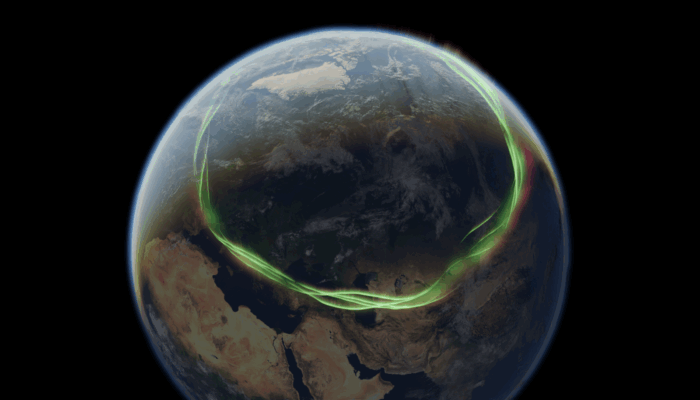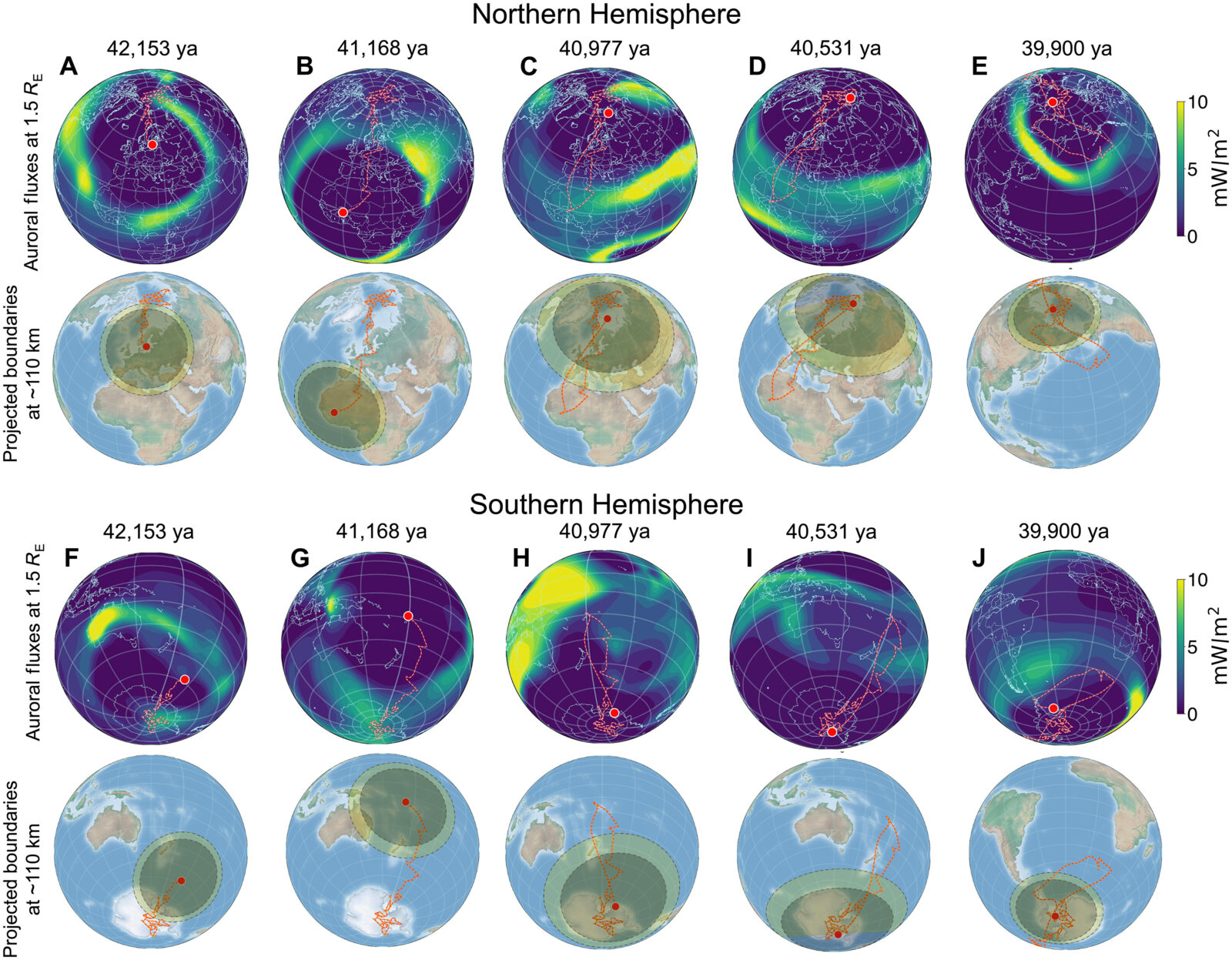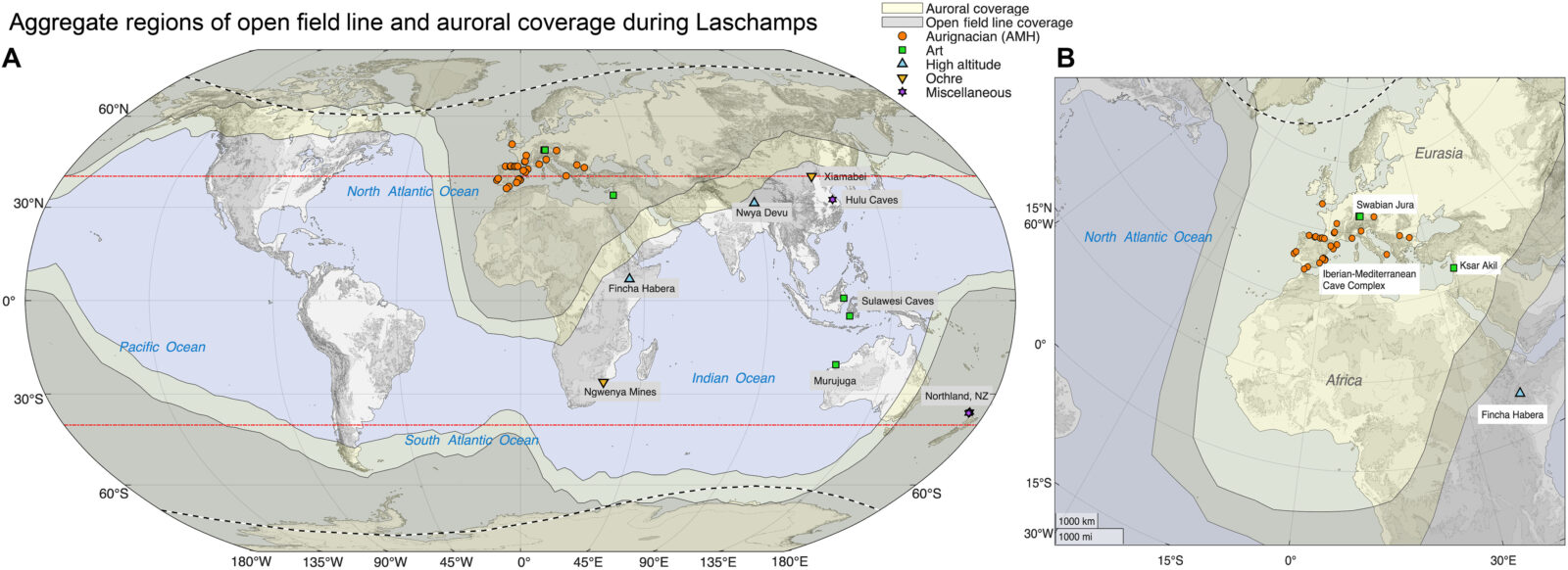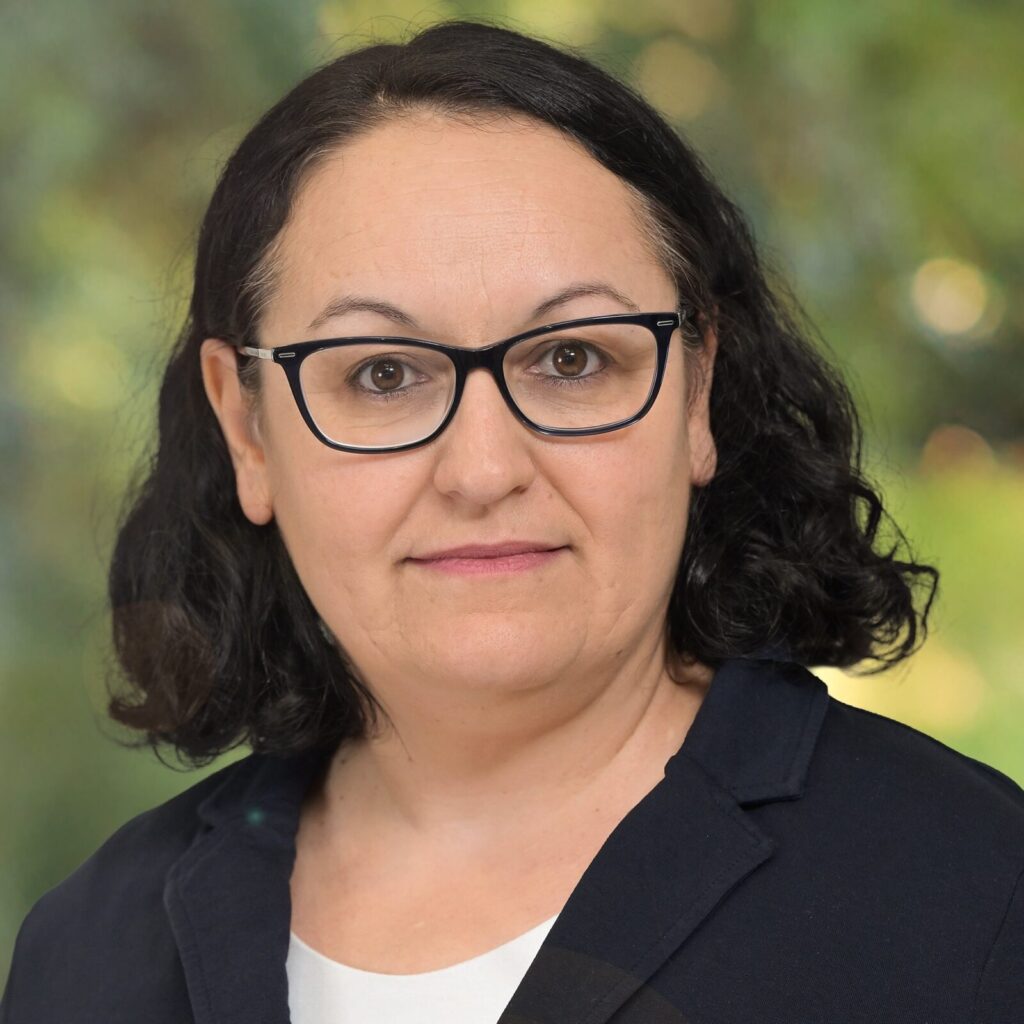
Approximately 41,000 years ago, during the Laschamps geomagnetic excursion, Earth’s magnetic field experienced a significant disturbance. The strength of the magnetic field decreased to only 10% of what it is today, the magnetic poles shifted considerably from the geographic poles, and the magnetosphere—the protective layer surrounding our planet—became smaller and distorted in previously unvisualized ways. For the first time, a recent study by Agnit Mukhopadhyay, Sanja Panovska, and colleagues (2025) has reconstructed the global space environment during this period, revealing how these alterations likely affected auroras, atmospheric chemistry, and even human behaviour (Wandering of the Auroral Oval 41,000 Years Ago, Sci. Adv. 11, eadq7275, DOI: 10.1126/sciadv.adq7275). We interview coauthors Agnit Mukhopadhyay and Sanja Panovska about their groundbreaking interdisciplinary work.
Your study presents a novel space physics perspective on the Laschamps geomagnetic excursion. What motivated you to investigate this particular event, and what makes it particularly intriguing to model?
Agnit: “The Laschamps geomagnetic excursion stood out to me as an exceptional event to study because it represents one of the most extreme and well-documented geomagnetic excursions in Earth’s recent history. From a space physics perspective, it provides a unique natural experiment to understand how Earth’s magnetosphere behaves under drastically reduced dipole conditions, something we cannot easily replicate today but can model with modern computational tools.
My motivation came from a convergence of interests. I had been working with global geospace models as part of my doctoral thesis, and I realized that by combining paleomagnetic data with space physics simulations, we could gain new insights into how the magnetosphere–ionosphere–thermosphere system may have functioned during the Laschamps event. Unlike the steady-state or storm-time magnetospheric responses we typically model for contemporary conditions, the Laschamps offers an opportunity to explore an entirely different parameter regime, one where the geomagnetic field strength drops to ~10–20% of its current value and the dipole axis is significantly displaced.”
The Laschamps geomagnetic excursion … provides a unique natural experiment to understand how Earth’s magnetosphere behaves under drastically reduced dipole conditions …
You have worked extensively on geomagnetic field reconstructions. What made applying those models to a period dating back 41,000 years particularly unique or challenging?
Sanja: “The models I am developing rely on data from paleomagnetic records; the key challenge lies in the temporal and spatial distribution of the data, as well as its quality. These records originate from geological archives, such as sediments and volcanic rocks, which preserve a record of the geomagnetic field from the time of their formation.
In general, the further back in time we go, the fewer data points are available, and the geographical coverage becomes increasingly sparse, particularly in the Southern Hemisphere. When it comes to data quality, two key aspects are crucial: the accuracy of the geomagnetic field components (intensity and direction), and the reliability of the chronological information. Without precise dating and robust measurements of field properties, the resulting models are overly smooth and associated with high uncertainties. It is important to remember that paleomagnetic models are limited in their resolution. They reconstruct large-scale features of the geomagnetic field and have limited temporal resolution, typically on the order of hundreds of years. Fortunately, ongoing efforts continue to produce new, high-quality, and high-resolution paleomagnetic data, enabling the construction of more robust models and expanding our understanding of geomagnetic behaviour over longer timescales.”
The paper mentions a dramatically weakened magnetic field and a compressed magnetosphere during the Laschamps excursion. How did this affect Earth’s radiation shielding?
Sanja: “Earth’s magnetic field acts as a protective shield, extending far into space and deflecting solar and cosmic radiation. Today, this magnetic shielding reaches up to about 10 Earth radii on the dayside. However, during geomagnetic excursions such as the Laschamps event, the magnetosphere shrank significantly, extending only 2–3 Earth radii. Moreover, it’s not just the size; the entire morphology of the magnetosphere changes. This results in substantially reduced shielding, or some regions, effectively no shielding at all, altering the conditions in the atmosphere and near-Earth environment.”
… during geomagnetic excursions such as the Laschamps event, the magnetosphere shrank significantly … This results in substantially reduced shielding, or some regions, effectively no shielding at all …
Agnit: “Building on what Sanja said, what fascinated me from a space physics point of view was how this reduction in field strength not only shrunk the physical size of the magnetosphere but also fundamentally altered the way it interacts with the solar wind. In our modelling, we observed that a reduction in dipole field strength caused the magnetosphere to become significantly more compressed and asymmetric, particularly on the dayside. This led to an unconventional coupling between the solar wind and the magnetosphere, resulting in more direct access for particles into near-Earth space. The result is that Earth’s natural radiation shield became far more porous. Solar energetic particles and galactic cosmic rays, which would normally be deflected or trapped by the geomagnetic field, could more easily penetrate to lower altitudes and latitudes. This meant increased radiation exposure not just in the polar regions, but potentially at mid and even low latitudes.
The weakened shielding would have had implications not only for the upper atmosphere (through enhanced ionisation and changes in conductivity) but also for the lower atmosphere, potentially contributing to compositional changes and climate fluctuations, or even influencing biomes through elevated radiation doses. For me, it was the opportunity to quantify and visualise this dramatic shift in geospace conditions using modern space weather models that made this aspect of the Laschamps event particularly compelling.”

Visualization of auroral charged particle energy flux variations and corresponding auroral zone wandering during the Laschamps excursion (Figure 3 from Mukhopadhyay, Panovska et al., 2025; DOI: 10.1126/sciadv.adq7275).
Your simulations show that auroral ovals expanded and migrated toward equatorial regions during the event. What were the most surprising findings regarding auroral activity from these simulations?
Agnit: “What surprised me most was how profoundly the auroral dynamics changed. In our simulations, auroral precipitation wasn’t limited to the familiar high-latitude oval structures of today’s dipole-dominated magnetosphere. Instead, it evolved into a near-global phenomenon—even under steady solar wind conditions—something we began referring to as a “global aurora” or “omni-aurora.” This behaviour stems from the fact that during the Laschamps excursion, the field was not only dramatically weaker but also multipolar and spatially disorganised. That meant the usual mapping between the solar wind-magnetosphere interaction and the auroral zones broke down. Field-aligned currents and particle precipitation could now access magnetic footprints at much lower latitudes, including regions that would be considered magnetically shielded under present-day conditions.
What was particularly striking was how this transformed the nature of auroral morphology: we saw diffuse, widespread electron precipitation that extended into regions that are typically quiescent in the modern era. It wasn’t just that auroras became visible at the equator during storms. They could occur routinely, even during mild space weather, because the structural integrity of the magnetosphere had degraded so significantly.
This has fascinating implications not only for the visual spectacle of aurorae in ancient skies but also for the electrodynamic coupling between the solar wind, magnetosphere, and ionosphere – a system that operated under entirely different rules than it does today.”
… auroral precipitation … evolved into a near-global phenomenon—even under steady solar wind conditions—something we began referring to as a “global aurora” or “omni-aurora.”
Sanja: “What stood out to me was the sheer geographical reach of the auroras during the Laschamps excursion. This wasn’t just an expansion of the auroral ovals—it marked a complete shift in their nature. The term “polar lights” no longer applied; these were truly global, or “omni-aurora,” events. Today, due to the strength and dipolar structure of Earth’s magnetic field, auroras are typically visible at lower latitudes during strong magnetic storms. However, about 41,000 years ago, the magnetic field was very weak and more complex with multiple poles rather than two poles, i.e., a simple dipole. This allowed auroras to be visible at low and equatorial latitudes under normal solar conditions.”
Your simulations show a marked equatorward shift and redistribution of auroral energy flux during the Laschamps excursion compared to modern conditions. How sensitive are these modelled auroral patterns to variations in solar wind parameters or interplanetary magnetic field (IMF) orientation, and did you test alternative input conditions to assess the robustness of your conclusions?
Agnit: “That’s an important question. In this initial study, we focused on a set of representative, steady-state solar wind conditions – moderate solar wind speed, density, and a southward-oriented IMF – which are known to effectively drive magnetospheric dynamics in the present-day system. While we have not yet explored the full range of solar wind variability or diurnal effects, our goal was to isolate the impact of the geomagnetic field configuration itself, particularly the reduced strength and multipolar structure during the Laschamps excursion. What we found was that even under modest and relatively stable solar input, the magnetosphere’s weakened structure was inherently more open and less capable of shielding against incoming solar wind energy. This led to a marked redistribution of auroral energy flux toward lower latitudes, and in some cases, near-global precipitation. In that sense, the equatorward shift and enhanced auroral activity appear to be robust features of the Laschamps-like magnetic field configuration, rather than artefacts of extreme solar conditions. That said, we recognise the need to expand this work by systematically varying input conditions to test the sensitivity and generality of these findings.”

Map showing the combined extent of auroral oval coverage (yellow-filled) and open field line regions (grey-filled) during the Laschamps event. Anthropological activity is displayed globally (A) and across the Europe–Maghreb region (B), with symbols marking sites of Aurignacian toolkits (orange circles), cave/portable art (green squares), ochre mining (yellow triangles), high-altitude occupation (blue triangles), and elevated radionuclide evidence (purple stars). The dotted black line indicates modern auroral boundaries under quiet solar conditions (Figure 4 from Mukhopadhyay, Panovska et al., 2025; DOI: 10.1126/sciadv.adq7275).
The paper explores how increased ultraviolet (UV) radiation may affect early human populations. How might such environmental changes have influenced human evolution and migration patterns? The idea that ochre may have been used as sunscreen by early humans is intriguing. What evidence supports this idea?
Agnit: “While our study doesn’t claim a direct causal link between geomagnetic conditions and human evolution, it highlights environmental stressors that may have influenced adaptive behaviours. Our modelling showed that during the Laschamps excursion, weakened magnetic shielding, and thus elevated UV exposure, coincided geographically with areas inhabited by both anatomically modern humans (AMH) and Neanderthals. This sets the stage for exploring how environmental pressures might have intersected with evolutionary and cultural developments.
What stood out to me was how the geomagnetic excursion could have imposed uneven ecological pressures, especially in mid-to-low latitude regions that don’t typically experience such elevated radiation levels. These conditions may have favoured populations already developing protective strategies, such as tailored clothing, sheltering in caves, or using ochre. The ochre hypothesis is particularly intriguing. While ochre use predates Laschamps, there is archaeological evidence of increased ochre processing, specifically at sites associated with AMHs during this time. Some researchers propose that ochre was applied to skin not just for symbolic or decorative reasons, but also as a functional barrier against UV radiation (functioning somewhat like a primitive sunscreen). Although this remains speculative, the temporal overlap between increased ochre use and the Laschamps provides an intriguing behavioural signal.
When viewed alongside other innovations like tailored clothing and symbolic expression (e.g., cave art), these behaviours suggest that AMHs may have been better equipped, both technologically and perhaps socially, to adapt to fluctuating and possibly more extreme environmental conditions. Whether this contributed to their eventual survival advantage over Neanderthals is an open question that our study does not address, but one that’s worth exploring further through interdisciplinary work bridging space physics, climate physics, archaeology, and human evolution.”
Sanja: “Our 3D modelling of the paleomagnetosphere, based on global paleomagnetic reconstructions, revealed that during the Laschamps event, extensive regions of open magnetic field lines likely exposed the surface to increased ultraviolet radiation. Notably, both AMH and Neanderthals occupied these high-risk areas at the time. To explore how this space climate context might connect to behavioural responses, we turned to the paleoanthropological and archaeological evidence. While the use of ochre as a form of skin protection predates the Laschamps and continues into modern traditional practices, there is a noticeable uptick in ochre processing and use at AMH-associated sites during the Laschamps period. In addition to ochre, other technological developments, such as advanced tools, tailored clothing, and cave art, are also linked to AMH. If the space climate brought more extreme environment over the Laschamps, these behaviours hint that AMH were better equipped to cope and thrive under such conditions.”
Some researchers propose that ochre was applied to skin … as a functional barrier against UV radiation (functioning somewhat like a primitive sunscreen) … the temporal overlap between increased ochre use and the Laschamps provides an intriguing behavioural signal.
In reconstructing the geomagnetic field, how did you ensure the accuracy and reliability of the data sources, and what methodologies were employed to validate your models?
Sanja: “The Laschamps excursion is the best-documented global geomagnetic excursion in terms of available data and modelling. Therefore, if we are to analyse the space climate during a geomagnetic excursion, the Laschamps event is the ideal candidate. Two of the most recently published models of the Laschamps, constructed using similar methodologies but constrained by different datasets, show good agreement in their reconstructed variations. Generally, the reliability of these models is enhanced by applying strict criteria when selecting sediment paleomagnetic data, improving chronologies with updated age calibrations, and ensuring regional consistency across records. Moreover, cosmogenic isotope production rates measured in ice cores and sediments, serving as completely independent proxies for the geomagnetic field, confirm the reconstructed variations based on paleomagnetic data.”
Modelling the magnetosphere under excursion conditions must have presented computational challenges. What were the key technical hurdles, and how did you overcome them?
Agnit: “Modelling the magnetosphere under excursion conditions posed several technical challenges, primarily because most global geospace models are optimised for a modern geomagnetic field: strong, stable, and dipolar. One of the first hurdles was adapting the input geomagnetic field to reflect the complex, weakened, and multipolar nature of the Laschamps excursion. We addressed this by incorporating paleomagnetic reconstructions into the model, replacing the standard geomagnetic field with a time-specific spherical harmonic field configuration representing ~41,000 years ago.
Another major challenge was ensuring numerical stability. The weak field strength and highly asymmetric magnetosphere made it challenging to maintain steady-state solutions using default model parameters. We had to fine-tune inner boundary conditions and solver settings, adjusting parameters like resistivity and mesh resolution, through iterative testing. Standard diagnostics such as bow shock location, magnetopause shape, or auroral ovals became unreliable under these conditions, so we developed new tools to track open magnetic field lines, energy deposition, and auroral particle precipitation within a disordered magnetosphere.
Despite these challenges, what made the effort worthwhile was the ability to simulate, for the first time in 3D, a Laschamps-era magnetosphere and link it to tangible geophysical and anthropological impacts. The project also opens up exciting possibilities for future simulation work across other paleomagnetic events.”
Looking ahead, what are your plans for further research in this area? Are there other geomagnetic events or periods you intend to study to gain deeper insights into Earth’s magnetic history and its effects on life?
Agnit: “My future research will continue to explore how geomagnetic excursions and reversals reshape the coupled magnetosphere–ionosphere–thermosphere system over geologic timescales. While the Laschamps event provided a striking case study, it also raised broader questions about how sensitive near-Earth space is to long-term magnetic variability and how such changes might ripple through atmospheric chemistry, climate processes, and even biospheric conditions.
A key next step is to systematically explore how different paleomagnetic field configurations, not just weakened, but also asymmetric or regional excursions, impact space climate under varied solar conditions. Using coupled models like the space weather modeling framework–global ionosphere thermosphere model (SWMF-GITM), I plan to incorporate time-dependent drivers, diurnal variations, and upper-atmosphere feedbacks. The goal is to move from single-event reconstructions to a more comparative, process-oriented understanding of Earth’s magnetic past.
I’m also keen to collaborate across disciplines – working with paleoclimatologists and archaeologists to integrate model outputs with proxy data and human occupation records. Ultimately, I see this research contributing to a broader narrative: not just how Earth’s magnetic field varies, but how that variability of a planet’s magnetic field may shape the environmental backdrop against which major climatological, evolutionary, or cultural shifts occur.”
Sanja: “There are many other geomagnetic events to explore! In the future, I plan to model more excursions, particularly those that occurred during the Brunhes Chron (the past ~780,000 years), for which we may now have sufficient data to conduct global studies. We ‘re particularly interested in whether all excursions share the same underlying mechanisms and produce similar effects. Some appear to be more regional or less intense than Laschamps, but they still offer important insights for understanding the full spectrum of geomagnetic variability.
Finally, there are geomagnetic reversals, when the magnetic field switches polarity. The most recent, the Matuyama-Brunhes reversal, is now represented with global models. These show a much extended period of field instability compared to the Laschamps excursion. However, the effects of this reversal on the paleoenvironment, paleoclimate, and space climate are still to be investigated.”


